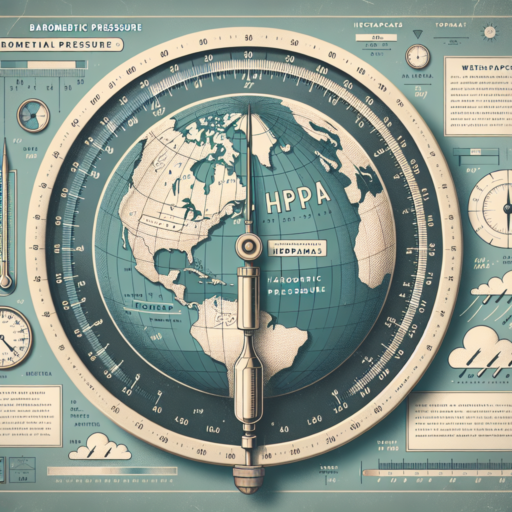Understanding Barometric Pressure in Hectopascals (hPa)
Barometric pressure, a crucial aspect of our atmosphere, is commonly measured in hectopascals (hPa). This measurement unit plays a key role in meteorology, offering insight into weather patterns and conditions. By understanding how barometric pressure is represented in hPa, we can gain a deeper appreciation for its influence on our daily weather.
The standard atmospheric pressure at sea level is about 1013.25 hPa. However, this value can vary depending on numerous factors, including altitude and weather conditions. When the barometric pressure is higher than the average, it often correlates with clear, stable weather conditions. Conversely, a decrease in pressure signifies the approach of stormy or unstable weather. Thus, tracking changes in barometric pressure in hPa allows meteorologists and weather enthusiasts to predict weather changes more accurately.
Key Factors Influencing Barometric Pressure Readings in hPa
- Altitude: Higher altitudes generally experience lower barometric pressures, as the density of air decreases with elevation.
- Temperature: Warm air tends to rise, causing lower pressure areas, whereas cool air tends to sink, increasing the barometric pressure.
- Weather Systems: High-pressure systems are generally associated with calm and sunny weather, while low-pressure systems can lead to precipitation and stormy conditions.
By paying attention to barometric pressure readings in hPa, individuals can better understand the current weather conditions and even make educated guesses about upcoming weather. Monitoring these changes can be particularly useful for planning outdoor activities, agricultural planning, and aviation operations. Recognizing the nuances of how barometric pressure in hPa influences weather patterns is essential for anyone interested in the science of meteorology.
How Barometric Pressure hPa Influences Weather Predictions
Understanding the impact of barometric pressure hPa (hectopascals) on weather forecasts is crucial for meteorologists and weather enthusiasts alike. This measurement is a key factor in predicting weather patterns, from clear skies to impending storms. Barometric pressure, measured in hectopascals, provides insight into the force exerted by the atmosphere at a specific point on Earth’s surface. As this pressure changes, it signals shifts in the weather, making it a vital tool for accurate forecasts.
When the barometric pressure hPa is high, it usually indicates stable and clear weather conditions. High pressure means that the air is descending, which discourages cloud formation and leads to clearer skies. Conversely, a drop in barometric pressure suggests that the atmosphere is becoming less dense and more unstable, often leading to cloud formation and precipitation. This fundamental principle allows meteorologists to predict weather changes with a degree of confidence.
Daily monitoring of barometric pressure changes helps in refining weather predictions. A sudden fall in hPa could indicate the approach of a low-pressure system, often associated with stormy weather and heavy rainfall. By tracking these fluctuations, meteorologists can provide timely warnings about severe weather, helping to minimize its impact on people’s lives. This data is essential not only for predicting immediate weather changes but also for longer-term forecasts, influencing everything from agriculture to maritime operations.
Reading and Interpreting Barometric Pressure hPa for Beginners
Understanding barometric pressure in hPa (hectoPascals) is crucial for weather prediction and many other scientific applications. For beginners, grasping the basics of how to read and interpret this measurement can seem daunting. However, by breaking down the process into digestible steps, anyone can start to comprehend the ins and out of barometric pressures and what they signify about our atmosphere.
What Is Barometric Pressure?
At its core, barometric pressure is the weight of the atmosphere overhead. Measured in hectoPascals (hPa), it is an indicator of weather changes. A rising barometric pressure often signifies fair weather, while falling pressure can indicate approaching bad weather such as storms or rain. Knowing how to read these changes plays a pivotal role in meteorology and even in planning everyday activities.
How to Read Barometric Pressure in hPa
Reading barometric pressure in hPa involves observing the value displayed on a barometer. Standard atmospheric pressure at sea level is around 1013.25 hPa. Values above this can suggest high pressure systems, synonymous with clearer skies, while values below point towards low pressure systems, and thus, potentially poorer weather conditions. Recognizing these basic patterns is the first step in interpreting barometric pressures.
The Significance of Barometric Pressure Changes in hPa on Your Health
Understanding the impact of barometric pressure changes on health is essential, especially when these fluctuations are measured in hectopascals (hPa). These variations, though often considered insignificant in daily weather forecasts, can profoundly affect our well-being. A shift in barometric pressure is not merely a predictor of weather changes; it symbolizes a potential determinant of physical and mental health responses among individuals.
When the barometric pressure drops, it can lead to an expansion of body tissues, which in some cases, causes pain, discomfort, or exacerbation of existing conditions. This phenomenon is particularly noticeable in individuals with arthritis or migraines. The pressure decrease often precedes stormy weather, leading to increased sensitivity in affected areas of the body, intensifying pain and discomfort. On the other hand, a rise in barometric pressure can have the opposite effect, potentially alleviating these symptoms.
Moreover, the changes in barometric pressure measured in hPa can also influence your cardiovascular health. A sudden drop in pressure can cause blood vessels to expand, leading to a reduced blood pressure that might result in dizziness or fainting spells in sensitive individuals. Conversely, an increase in pressure can trigger blood pressure spikes, posing risks for people with hypertension. Recognizing these patterns can help in preemptively managing potential health issues related to barometric pressure changes.
Comparing Barometric Pressure Units: hPa vs. mmHg vs. inHg
Understanding the different units used to measure barometric pressure is crucial for both meteorological and scientific purposes. Barometric pressure, which is the pressure within the atmosphere of the Earth, can be recorded in several units, including hectopascals (hPa), millimeters of mercury (mmHg), and inches of mercury (inHg). Each of these units provides a unique perspective on atmospheric pressure readings and can be used in different contexts.
The hectopascal (hPa) is considered the standard unit for measuring atmospheric pressure in meteorology. It is equivalent to one millibar and is recognized for its precision and universal application in weather forecasts around the world. One of the key advantages of using hPa is its direct correlation with the Pascal (Pa), the SI unit for pressure, which simplifies scientific calculations and analyses.
On the other hand, millimeters of mercury (mmHg) and inches of mercury (inHg) are units that have historically been used in various applications, including medicine and aviation. The mmHg measures pressure in terms of the height of mercury in a column, as does the inHg, with the primary difference being the unit of measurement (millimeters versus inches). While both are less commonly used in general meteorology today, they remain significant in specialized fields due to their traditional applications and the intuitive understanding they offer of pressure changes relative to the historical use of mercury barometers.
Differences and Applications of hPa, mmHg, and inHg
- hPa – Widely used in meteorology. Offers a direct relationship with the Pascal, making it easy to use in scientific research.
- mmHg – Often found in medical settings (e.g., blood pressure measurements) and remains relevant in specific areas of aviation and scientific experimentation.
- inHg – Commonly used in the United States for aviation and meteorology. Provides a historical perspective on atmospheric pressure measurement.
Tools and Apps for Monitoring Barometric Pressure hPa in Real-time
Monitoring barometric pressure in real-time is essential for various professionals like meteorologists, pilots, and even outdoor enthusiasts who want to predict weather changes accurately. With advancements in technology, several tools and apps have become available, making it easier to monitor barometric pressure in hectopascals (hPa), which is the standard measurement unit. These tools have transformed how we access, analyze, and utilize atmospheric pressure data.
Mobile Applications Offering Precision
One popular method for keeping an eye on barometric pressure is through mobile apps. These applications are designed to provide users with real-time data and historical pressure trends right at their fingertips. Apps like Barometer & Altimeter and WeatherSignal use your phone’s built-in sensors to measure atmospheric pressure accurately. They offer features such as notifications for sudden pressure changes, which could indicate an imminent weather change, making them invaluable for planning outdoor activities or any event that might be affected by the weather.
Dedicated Hardware Devices
For those requiring even more precision and reliability, dedicated barometric pressure monitors are available. These standalone devices are often used in professional settings where accurate weather predictions are crucial. They typically provide more detailed data than mobile apps and can be connected to personal computers to graph and analyze atmospheric pressure changes over time. Brands like AcuRite and Kestrel are known for their reliable and accurate barometric sensors, catering both to enthusiasts and professionals alike.
Barometric Pressure hPa: Historical Data and Its Importance in Climatology
The historical data of barometric pressure, measured in hectopascals (hPa), serves as a vital component in the field of climatology. Through the detailed records of barometric pressure, climatologists can unlock valuable insights into the patterns and changes in our atmosphere over time. This historical dataset not only helps in understanding past weather conditions but also plays a crucial role in projecting future climatic events.
One of the key benefits of analyzing historical barometric pressure data is its ability to highlight trends in atmospheric conditions. By examining the fluctuations in pressure readings over decades or even centuries, researchers can identify long-term climatic trends such as global warming or cooling phases. These trends provide essential clues for understanding the dynamics of climate change and how it affects global weather patterns.
Applications in Weather Prediction and Climate Research
The importance of historical barometric pressure data extends beyond academic interest; it has practical applications in weather prediction and climate research. Meteorologists rely on past pressure readings to refine their weather prediction models, making forecasts more accurate. Furthermore, by studying this data, scientists can improve their understanding of extreme weather events (such as hurricanes and cyclones), which are often influenced by significant changes in atmospheric pressure. Thus, the continual collection and analysis of barometric pressure hPa data is indispensable for both advancing scientific knowledge and protecting communities from the impacts of adverse weather conditions.
Practical Tips for Adjusting Your Activities Based on Barometric Pressure hPa Readings
Understanding the influence of barometric pressure hPa readings on your daily activities can be a game changer, particularly if you’re an outdoor enthusiast or someone sensitive to weather changes. The barometric pressure, or atmospheric pressure, measured in hectopascals (hPa), can affect both the weather forecast and your well-being. Therefore, learning how to adjust your activities accordingly can significantly enhance your comfort and safety.
Outdoor Activity Planning
When planning outdoor activities, keeping an eye on the barometric pressure trends can be incredibly insightful. A rising barometric pressure usually indicates improving weather conditions, making it ideal for hiking, biking, or gardening. On the contrary, a falling barometric pressure suggests deteriorating weather conditions, potentially leading to storms or heavy rainfall. Before heading out, check the pressure trend and consider postponing if a significant drop is observed.
Health and Well-being Considerations
Fluctuations in barometric pressure can also impact individuals with certain health conditions, such as migraines or arthritis. A rapid decrease in pressure is often associated with increased discomfort. If you’re susceptible to such conditions, it’s prudent to be proactive by planning low-impact indoor activities during periods of falling pressure. Engaging in yoga, gentle stretching, or mindfulness exercises can help mitigate the negative effects on your body.
Angling and Fishing Adjustments
Anglers know that barometric pressure can significantly affect fish behavior, making it a crucial factor to consider when planning a fishing trip. Typically, fish are more active during periods of stable or slightly rising pressure. It’s the perfect time to venture out as your chances of a successful catch are higher. However, during periods of rapidly falling pressure, fish tend to be less active and may not feed as aggressively. During such times, focusing on deeper waters or adjusting your techniques may help in making your trip worthwhile.
Barometric Pressure hPa and Its Role in Aviation: What Pilots Should Know
Understanding the significance of barometric pressure hPa (hectopascals) is fundamental for pilots operating in the fast-paced and ever-changing environment of aviation. This measure of atmospheric pressure plays a crucial role in several aspects of flight planning and in-flight operations, influencing everything from altitude readings to weather forecasting. Recognizing the intricacies of how barometric pressure affects aviation can markedly improve a pilot’s ability to anticipate and react to the conditions they may encounter.
The relationship between barometric pressure hPa and altitude is one of the most critical aspects that pilots must grasp. As a plane ascends, the density of air—and consequently, the barometric pressure—decreases. This decrease impacts the aircraft’s altimeter settings, which are pivotal for maintaining a safe flight altitude. Inaccuracies or ignorance of the current barometric pressure can lead to erroneous altitude readings, a scenario that holds especially true in areas of significant atmospheric pressure variation or in severe weather conditions.
Moreover, barometric pressure hPa is integral to accurate weather forecasting, a tool indispensable to aviation. Changes in pressure can signal the impending shifts in weather patterns, allowing pilots to adjust their flight paths accordingly. A sharp drop in barometric pressure, for example, often precedes stormy weather, which could necessitate a reroute or even a delay to ensure safety. Hence, staying updated with the latest barometric pressure readings is not just beneficial but essential for effective flight planning and execution.
FAQs About Barometric Pressure hPa: Everything You Need to Know
Understanding barometric pressure in hPa (hectopascals) is crucial for weather forecasting, navigation, and even your daily weather-related health symptoms. Here, we delve into the most common questions surrounding this topic, providing you with the essential insights you need.
What is Barometric Pressure Measured in hPa?
Barometric pressure, or atmospheric pressure, is the force exerted onto a surface by the weight of the atmosphere above that surface. It is commonly measured in hectopascals (hPa), which is a unit of pressure equivalent to the millibar (mb). Historically, the millibar was the unit used in meteorology, but the International System of Units (SI) adopted the hectopascal to bring meteorological measurements into alignment with other scientific fields. One hPa equals 100 pascals and, importantly, 1013.25 hPa is considered the standard atmospheric pressure at sea level under average conditions.
Why is Barometric Pressure Important?
Barometric pressure is a key indicator of weather changes. A rising barometric pressure often means improving weather conditions, while a dropping barometric pressure can indicate worsening weather, such as storms or rain. Beyond weather prediction, changes in barometric pressure can also affect individuals’ physical well-being, with some people experiencing headaches or joint pain when pressures fluctuate. Additionally, it plays a critical role in the field of aviation and marine navigation, where accurate pressure readings are essential for altitude and depth determination, respectively.
How Does Barometric Pressure Affect Weather Forecasts?
The measurement of barometric pressure is instrumental in weather forecasting. Meteorologists track changes in atmospheric pressure over time to predict short-term weather patterns and storm movements. For instance, a rapid decrease in hPa readings can suggest an approaching storm system, while a steady increase might point to clearer skies ahead. By analyzing these trends alongside other meteorological data, forecasters can provide more accurate weather predictions, helping individuals and businesses plan more effectively for the conditions ahead.










